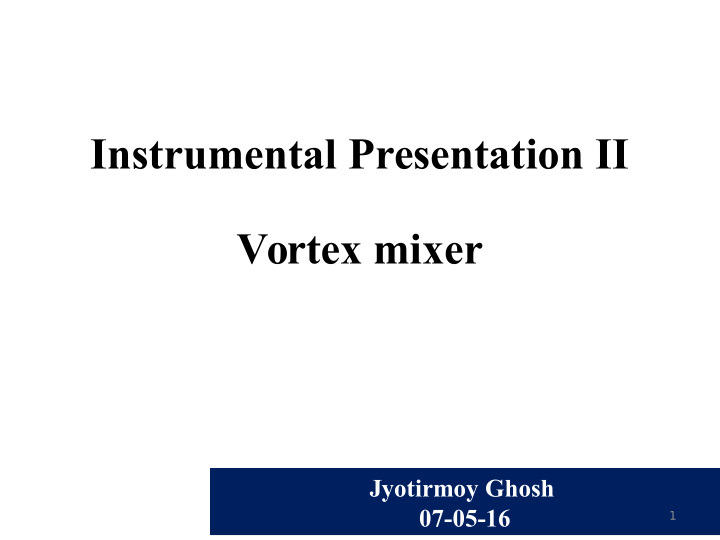



Instrumental Presentation II Vortex mixer Jyotirmoy Ghosh 07-05-16 1
Introduction A vortex mixer, or vortexer, is a simple device used commonly in laboratories to mix small vials of liquid. When a test tube or other appropriate container is pressed into the rubber cup (or touched to its edge) the motion is transmitted to the liquid inside and a vortex is created. The vortex mixer was invented by the Kraft brothers (Jack A. Kraft and Harold D. Kraft) in 1959 while working for Scientific Industries. Front view of a Vortex mixer 2
Vortex mixer IR Mixing Sensors cup head Mode select button Speed select knob On-off switch Automatic mode indicator light 3
Operating principle It consists of an electric motor with the drive shaft oriented vertically and attached to a cupped rubber piece mounted slightly off-center. As the motor runs the rubber piece oscillates rapidly in a circular motion. When a test tube or other appropriate container is pressed into the rubber cup (or touched to its edge) the motion is transmitted to the liquid inside and a vortex is created. Most vortex mixers have variable speed settings and can be set to run continuously, or to run only when downward pressure is applied to the rubber piece. The Vortex Mixer units offer the possibility of either automatic or continual mode start up: mixing speed for both work modes can be selected with knob. Selecting the continual mode, the stirring is always on to the selected speed. Red light indicates the automatic modality of the instrument. 4
General description The mixer is made from Zinc alloy die-cast and has three rubber feet and a low profile to keep the unit in place during operation in all working conditions. The mixer works at voltages of between 90 to 260 V with a frequency of 50 to 60 Hz . The unit’s electronics permit uniform high precision regulation at any mixing speed between 0 to 3000 rpm. Samples in a lab mixer can be agitated via a linear motion or by an orbital motion to create a vortex in the solution. There are two types of models of this mixer- a. Classic Model b. Wizard Model 5
Classic Model Mixing starts as the tube is pressed onto the cup head. By selecting the automatic “Touch” mode with the button on the front panel (indicator light on) mixing starts up when the tube is lightly pressed down on the cup head. 6
Wizard Model Mixing starts automatically when the tube crosses the sensor field (infrared optical system). The sensor field has been purposely designed to detect the presence of any kind of tube to be mixed. Mixing starts automatically when the tube enters the shaded area, without the need for any pressure on the cup head. IR region 7
Application Vortex mixers are quite common instrument in bioscience laboratories. In cell culture and microbiology laboratories they are used to suspend cells. In a biochemical or analytical laboratory they may be used to mix the reagents of an assay or to mix an experimental sample and a dilutant. The technique is better suited to accelerate the mixture of solutions which do not require the kinetic energy input needed to create suspensions. Thank you 8
Recommend
More recommend